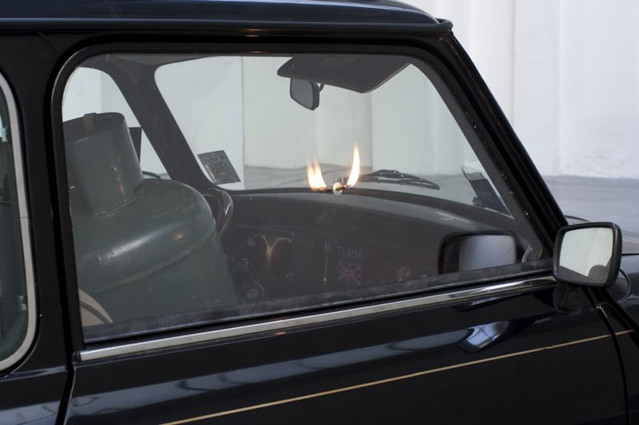Reverse Engineering
30 Apr - 06 Jun 2010
Reverse engineering. Noun. Reproduction of another manufacturer’s product after detailed examination of its construction or composition.
Oxford English Dictionary
Galerija Gregor Podnar is pleased to announce its second solo show with artist Ariel Schlesinger. “Reverse Engineering” presents A Car Full of Gas, together with a selection of recent sculptures.
If beauty can be found in any slight shift in the rhythms of the world, in temporal or functional disruptions, Ariel Schlesinger will be there to capture it – he might even have provoked it himself. His practice creates a tension between the materiality of mass-produced workaday objects, and the function these objects were intended for. The artist introduces a subtle disruption to consumer goods, not by dramatically modifying their external appearance, but rather by “enhancing hidden aspects of their existence”. In renewing how we regard such objects he makes an often trivial reality sublime.
Born in Jerusalem in 1980, Ariel Schlesinger lives and works in Berlin. As a teenager, he practiced train hopping in California, and developed a taste for the improper use of objects – creatively appropriating established normative conditions. Taking this liberating experience as a starting point, the artist began to seek out other latent opportunities for the subversion of the everyday, by modifying consumer devices or accessing features in them that had been disabled by the manufacturer.
In the sculptures shown here, Ariel Schlesinger applies techniques inspired by the reverse engineering process – by tapping into the process of their creation, he investigates hidden possibilities trapped in devices. The largest of these pieces incorporates an old Mini Cooper. Two large tanks filled with cooking gas are placed in the passenger compartment, and a small flame comes out of a hole drilled in the window.
Oxford English Dictionary
Galerija Gregor Podnar is pleased to announce its second solo show with artist Ariel Schlesinger. “Reverse Engineering” presents A Car Full of Gas, together with a selection of recent sculptures.
If beauty can be found in any slight shift in the rhythms of the world, in temporal or functional disruptions, Ariel Schlesinger will be there to capture it – he might even have provoked it himself. His practice creates a tension between the materiality of mass-produced workaday objects, and the function these objects were intended for. The artist introduces a subtle disruption to consumer goods, not by dramatically modifying their external appearance, but rather by “enhancing hidden aspects of their existence”. In renewing how we regard such objects he makes an often trivial reality sublime.
Born in Jerusalem in 1980, Ariel Schlesinger lives and works in Berlin. As a teenager, he practiced train hopping in California, and developed a taste for the improper use of objects – creatively appropriating established normative conditions. Taking this liberating experience as a starting point, the artist began to seek out other latent opportunities for the subversion of the everyday, by modifying consumer devices or accessing features in them that had been disabled by the manufacturer.
In the sculptures shown here, Ariel Schlesinger applies techniques inspired by the reverse engineering process – by tapping into the process of their creation, he investigates hidden possibilities trapped in devices. The largest of these pieces incorporates an old Mini Cooper. Two large tanks filled with cooking gas are placed in the passenger compartment, and a small flame comes out of a hole drilled in the window.

